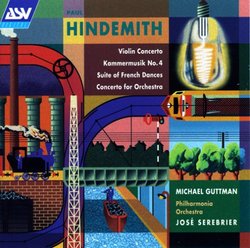A HEFTY, HEADY HUNK OF HINDEMITH!
Melvyn M. Sobel | Freeport (Long Island), New York | 11/07/2000
(4 out of 5 stars)
"No doubt Hindemith is an acquired taste. His "Mathis der Mahler" (or the "Kammermusik," perhaps) usually starts the ball rolling for most of us, initially. And, then, we either pursue his compositions... or we don't. Simple. Although never a composer of interest to me, or of choice, I still found this CD attractive and fascinating, especially in its variety, scope and broad representational value. (Up somewhere in the great, sparkling cosmos, Herr Hindemith is smiling!)
The Concerto for Orchestra, Op. 38 is a quirky, ingenious four movement work that should really be called "Concerto Grosso for Orchestra," so similar in manner is it to Ernest Bloch's compositions bearing this tag, and drawing as it does so inventively on baroque elements. At just over twelve minutes, Hindemith, like Bloch, fuses the 16th century with the 20th, melds them, and produces a delicious musical hybrid, full of color, delectable solo outings (by oboe, flute, bassoon and violin), and a surging, bubbling forward motion that is infectious.
The Concerto for Violin (1939), played with great feeling and elan by violinist Guttman, whose "realization" of this work brings it to full measure superbly, is Hindemith's only large-scale orchestral coupling of this nature, running some thirty-one minutes in its three movements. It's a brilliant work! Powerful, heady, emotional and, dare I admit it, actually quite beautiful, especially in the central Langsam.
Guttman reprises his phenomenal artistry in Kammermusik No. 4 (Op. 36, No. 3), written, remarkably enough, in 1925--- the same year as the Concerto for Orchestra!--- yet worlds apart, musically. Indeed, as suggested by its title, this is rather more a "chamber music ensemble concerto" for violin than either an actual chamber work or concerto. This is, as well, essentially, the Hindemith with whom we're more familiar: experimental and dissonant. Although less immediately attractive or endearing than the other compositions on this CD, the Kammermusik No. 4 still ingratiates itself... slowly.
Most surprising is the Suite of French Dances, composed in 1958, and basically Hindemith transcriptions of 16th century dance tunes. (Poulenc had already done similarly, using many of the same tunes, in his Suite Francaise.) It's a pleasant "hommage" to the period and a grand way to cleanse one's musical palette.
The closing Ragtime throws all caution to the wind in its jazzy take on Bach's C Minor Fugue from Book 1 of his Well-tempered Klavier. Clever and fun.
With fine playing from the Philharmonia Orchestra, under Serebrier, clear, crisp sound, and the magical work by Michael Guttman, this all-Hindemith CD is well worth looking into.
[Running time: 78:18]"
The violin concerto -- wonderously soaring and accessible.
Tom Brody | Berkeley, CA | 07/03/2006
(5 out of 5 stars)
"The violin concerto is wonderously soaring and accessible. The "accessible" music of Hindemith includes, for example, Mathis der Maler, Symphonic Metamorphosis on Themes of Carl Maria von Weber, and the Violin Concerto.
In my opinion, the Hindemith Violin Concerto is just as much a wonder to behold, as the popular Bruch, Mendelssohn, and Prokofiev violin concertos, and it deserves to be more in the public eye.
In contrast, for some reason, many of Hindemith's other compositions have a sort of unfinished or "first draft" quality to them.
Ragtime, also on this album, is interesting. It is a comical piece, reminiscent of Stravinsky's Circus Polka for a Young Elephant, and Charles Ives' Halloween. Ragtime features a musical laughing episode. Laughing music also occurs, for example, in Aaron Kernis' symphonic piece, The Colored Field, at 2 minutes and again at 3 minutes, in the second movement. One can also find a laughing episode in Bartok's string quartet no.1, where the laughing occurs at 6-7 minutes into the 3rd movement (allegro vivace)."


 Track Listings (20) - Disc #1
Track Listings (20) - Disc #1